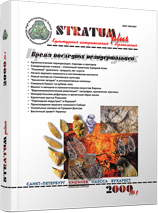Рубеж среднего и позднего палеолита на Северном Кавказе
The Middle to Upper Paleolithic Interface in the Northern Caucasus
Author(s): L. V. GolovanovaSubject(s): History, Archaeology
Published by: Издательский дом Stratum, Университет «Высшая антропологическая школа»
Keywords: Kamennomostskaya Cave; Upper Paleolithic site; Northern Caucasus; Formozov;
Summary/Abstract: During many years Kamennomostskaya Cave was considered the earliest Upper Paleolithic site in the Northern Caucasus (Formozov 1965). There are no absolute dates for this site. The early age was established only on the basis of technique-typological characteristics of the industry. The situation has radically changed after the discovery of a new site at Mezmaiskaya Cave. In 1997 three Upper Paleolithic layers 1A, 1B, and 1C were discovered in the Mezmaiskaya cave, Northern Caucasus. They all consist of loamy deposits with small rubbles. While Layer 1A may date to the final Late Pleistocene, Layer 1C yielded an assemblage of the Upper Paleolithic artifacts and an AMS date on charcoal from a hearth of 32.010±250 ka BP (Beta — 113536). The assemblages from layers 1A and 1B are chiefly comprised of unretouched blades and flakes. Retouched lithic items include end-scrapers, backed blades, and Gravette points. Non-lithic tools include bone awls and bone and ivory points. Ivory was, probably, imported from lower elevations. These assemblages are similar to previously reported Upper Paleolithic sites in the Northern Caucasus that are believed to date from the final Upper Paleolithic. The assemblage from Layer 1C is different. It contains end-scrapers on massive flakes and large blade fragments, dihedral and multifaceted burins, points, including points on microblades, and backed blades. Non-lithic implements include bone awls and points. Layer 1C lay over the uppermost Mousterian layer 2, which has a radiocarbon date on bone 32.230±740 ka BP (LE — 4735). Now it is impossible to determine how big the chronological gap between these layers is. One can say only that layer 1C was formed after an erosional episode which disturbed the roof of layer 2. The industry of layer 2 represents a late stage of the Northern Caucasus Micoquian development. The industry of the Kamennomostskaya cave typologically dated to the beginning of the Upper Paleolithic is close to these sites. The industry of layer 1C at Mezmayskaya sharply differs from them and, possibly, marks a penetration of a new innovative wave into the Northern Caucasus right at the beginning of the Upper Paleolithic. This industry is distinguished by a highly developed blade technology resulting in a high proportion of bladelets, a presence of crested blades and tablets. Tools are dominated by backed blades and bladelets. Now the industry has no close analogies in the Northern Caucasus, and there are no absolute dates for the Trans-Caucasus Upper Paleolithic sites typologically close to it. In its highly developed blade technology the industry of layer 1C resembles the Ahmarian sites of the Near East. These analogies are, undoubtedly, not complete, especially in typological compositions. In any case, this assemblage represents the first reliable evidence of the early Upper Paleolithic industry on the Northern Caucasus. The inventory of the Kamennomostskaya cave includes convergent tools, simple side-scrapers, notched tools, and denticulates. There are only 3 backed blades and a point on blade with two symmetrically backed edges. Technological and typological indices of the industry are close to the Final Mousterian industries of Monasheskaya, Mezmaiskaya caves, and Gubs Rock-shelter 1. The Kamennomostskaya industry seems to be a continuation of the Mousterian industries of this region.
Journal: Stratum plus. Археология и культурная антропология
- Issue Year: 2000
- Issue No: 1
- Page Range: 158-177
- Page Count: 20
- Language: Russian
- Content File-PDF

